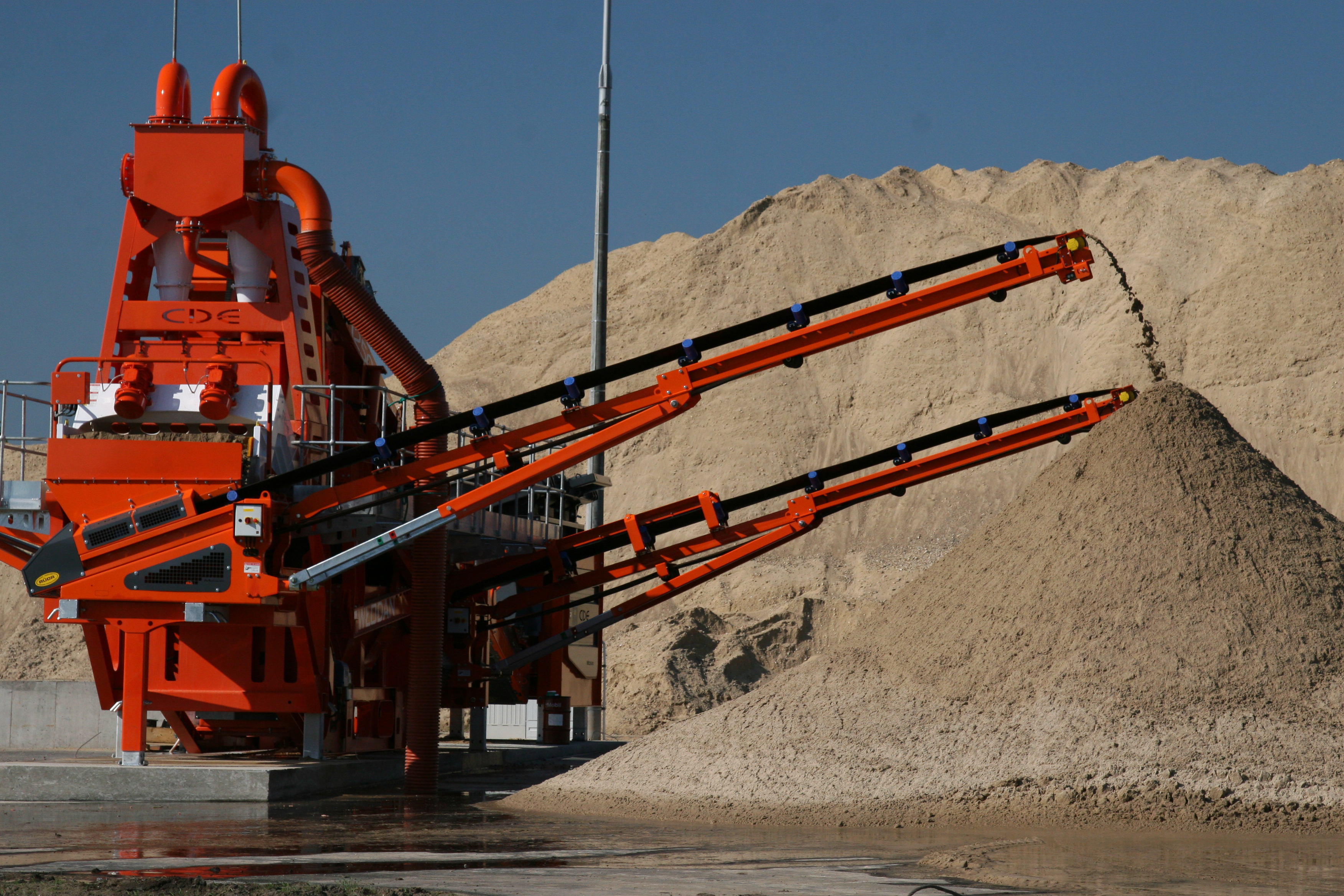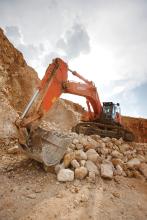
It has often been said that Poland is ‘one huge construction site’ though in reality the accuracy of that particular sobriquet fluctuates with the state of the economy as much as it might for any country. Julie-Anne Ryan reports
The aggregates industry in Poland was at its height in 2007, when the construction industry was going full tilt, accounting for more than 70% of the consumption of aggregates.
When the global financial crisis took hold the following year, demand went down there as it did everywhere. But while many countries in Europe have been slow to recover, Poland has forged ahead. In 2007, the size of the aggregates market in Poland was similar to that of Ireland. Yet by 2010, the Polish market was three times that of its Irish counterpart.
A number of major road schemes are planned in Poland and these will help to push aggregates demand up by 20% country over the next few years.
CDE washing plant for Wlodan
Wlodan has introduced the M2500 mobile washing plant from CDE Global to its operations on the outskirts of Lodz in central Poland.
It is being used to process a variety of materials including sand and gravel from Wlodan’s own quarry as well as crushed granite. Wlodan has operated in the Lodz area since 1989 and has been involved in the supply of material to all of the major new road development and repair projects in the area.
The material from the new M2500 washing plant will be used by Wlodan in the asphalt and readymix concrete plants it operates.
The introduction of a washing plant was required as a result of the high level of -2mm fraction within the natural sand and gravel at the Wlodan deposit. In order to ensure effective and efficient recovery of this material it was felt that a washing plant was the only viable option.
“Given the requirement on this project to ensure efficient recovery of a very fine sand fraction our technology was a good fit for Wlodan” explains Roman Gorski, CDE sales manager for Poland.
Delivery of the new plant for Wlodan was undertaken by the CDE distributors for Poland, Ruda Trading International.
In fact, the optimism in the industry here centres largely on the construction of these roads. The Polish Aggregates Producers Association states that: “The Polish economy cannot function without the construction, modernisation, conversion and repair of buildings and infrastructure, including transport. Especially, the implementation of the construction of new roads and rail routes and major remodelling, is a prerequisite for real consistency with the
Poland produced in total nearly 230 million tonnes of aggregates in 2011: demand in just the first six months got to 110million tonnes, six million tonnes up on the same period a year earlier. It’s record-breaking, and the investments that are driving the huge figures are thanks to commercial construction projects, which have a 60% share in total aggregate consumption.
Infrastructure construction accounts for 30%, while 10% is held by other construction segments. Only 4% of the aggregates consumed in Poland are imported.
Over the next three years, the construction of public roads and rail routes will use about 190million tonnes of aggregates and 200million tonnes of earth masses, rock and other materials for embankments, access roads and driveways associated with the projects.
It’s important to note that new legislation that came into force on 1 January, 2012, may have an impact on further growth in the industry, and the quarrying sector is waiting for full clarification of the new rules. The new laws are aimed at reducing illegal quarrying activity to create fair competition between legal operations.
In terms of resources, Poland’s geological deposits are distributed unevenly. Almost all the resources of rock materials are located south of the line Wroclaw-Kielce, and more than two-thirds of the gravel and sand deposits occur north of that line.
Table 1 shows the types and stocks of rock materials that form the basis for the production of natural aggregates.
| Type of material |
Deposits identified |
Deposits developed |
% 3/2 |
Geological Resources |
Industrial Resources |
% 6/5 |
|---|---|---|---|---|---|---|
| A | 2 | 3 | 4 | 5 | 6 | 7 |
| Broken Stone and lateral | 685 | 292 | 42.6 | 9784 | 4720 | 48.2 |
| Sand and gravel for construction | 7323 | 2670 | 36.4 | 16245 | 4038 | 24.9 |
| Dolomites | 12 | 4 | 33.3 | 354 | 153 | 43.2 |
| Refractory Quartzites | 18 | - | - | 7 | - | - |
| Limestones and marls Cement and lime | 180 | 34 | 18.9 | 18265 | 6053 | 33.1 |
| Together | 8218 | 3000 | 36.5 | 44655 | 14964 | 33.5 |
The degree of field development, both in terms of their amount and size of the stocks, makes the situation seem sound, says the association.
But it could be that after several years of growth and stabilisation, that “unreasonable environmental requirements” may limit the potential production. Forecasts say that after 2020 there could be restrictions on access to resources and lack of a sufficient base for sands and gravels, and after 2050 crushed natural aggregates.
Aggregate forecast for 2011-2015 is based on observations and available information related to the raw material base. For natural aggregates these are mineral deposits and for artificial aggregates, the existing landfill and the current production of steel and copper smelters, plus the recycling of the materials obtained from demolition and reconstruction.
Economically, accession to the European Union (EU) resulted in a substantial Polish participation in the budget breakdown for the years 2007-2013, and these measures helped to start the modernisation and development of many sectors of the economy in Poland. A large proportion of the funds received are spent on infrastructure, mainly roads, with the aim of synchronising them with the European transport system.
Logistics within the industry is an area of concern, and the association sees the reduction of road traffic in terms of transporting aggregates from quarry to works sites as being a major requirement. Metso’s big screens for Poland
The customer, Georyt Witkowski Krzysztof, located in the south of the country, produces some 3million tonnes of aggregates (soft rocks, sand and gravel) per year at three locations. All its sites are equipped with Metso machines (mobile units LT and ST, cone crushers HP classic series and new range HP4, circular and elliptical screens series CVB and TS).
The delivered TS6.2 screen is a two-deck screen equipped with internal washing system and takes the feed of 0/16mm. Each deck has Metso Trellex LS PU screening media for dewatering and screening sand 0/2mm and production of 2/8mm and 8/16mm fractions.
The delivered TS6.3 screen is a three-deck screen for dry process with woven wire meshes to separate fractions 0/4(2)mm, 4(2)/8mm, 8/12mm and 12/16mm. The capacity is 470tonnes/hour.
The screen is equipped with Metso dust protection system Trellex Dust Control which significantly improves working conditions and is environmentally friendly.
In the first quarter of 2011, six million tonnes of aggregates were transported by rail, twice as much as in the first quarter of the peak year, 2007. In 2011 about 25 million tonnes is estimated to have been transported by rail, despite the poor condition of some of the railway infrastructure.
But Aleksander Kabziski, president of the association, has said that “the main problem, transportation, begins to outweigh the problem of access to mineral deposits. I predict that it will soon be the main brake. We must take seriously the principle of sustainable human development, wildlife, economy, and listen to the requests of professional conservationists.”
The association’s 47 members are committed to return to the principles of sustainable development, including the dissemination of knowledge about Natura 2000 and to define requirements for operations in the areas covered by it, in the form of real plans of protective duties. There is also an emphasis on full use of the railway system “as a common good of the national economy”, and a requirement that “aggregate producers should produce only safe construction products”.
By 2013, it is estimated that aggregates demand in Europe will be nearly 5% higher than in 2010. While Poland is expected to be among the best-performing countries, the total market will still be below typical levels experienced in the last decade.
Kabziski has stated that the industry has potential, but that much depends on whether in the next financial year it receives significant support from the EU.
| Years: | 2011 | 2012 | 2013 | 2014 | 2015 | SUM 2011-15 |
|---|---|---|---|---|---|---|
| (1) Natural aggregates broken | 70 | 60 | 55 | 50 | 50 | 285 |
| (2) Natural gravel aggregates | 140 | 140 | 140 | 140 | 145 | 705 |
| Natural aggregates (1+2) | 210 | 200 | 195 | 190 | 195 | 990 |
| (3) Aggregates artificial | 6 | 6 | 6 | 5 | 5 | 28 |
| (4) Recycled aggregates | 8 | 10 | 15 | 15 | 15 | 63 |
| Secondary aggregates | 14 | 16 | 21 | 20 | 20 | 91 |
| Aggregates (1-4) | 224 | 216 | 216 | 210 | 215 | 1081 |
| Mg / capita (When 38 million) | 5.9 | 5.7 | 5.7 | 5.5 | 5.6 | 28.4 5.6 |
| Demand for road [million tonnes] (With rail) | 35 | 35 | 30 | 30 | 25 | 155 |
| The demand for road [%] Of rail | 15.6 | 16.2 | 13.9 | 14.3 | 11.6 | 14.5 |






